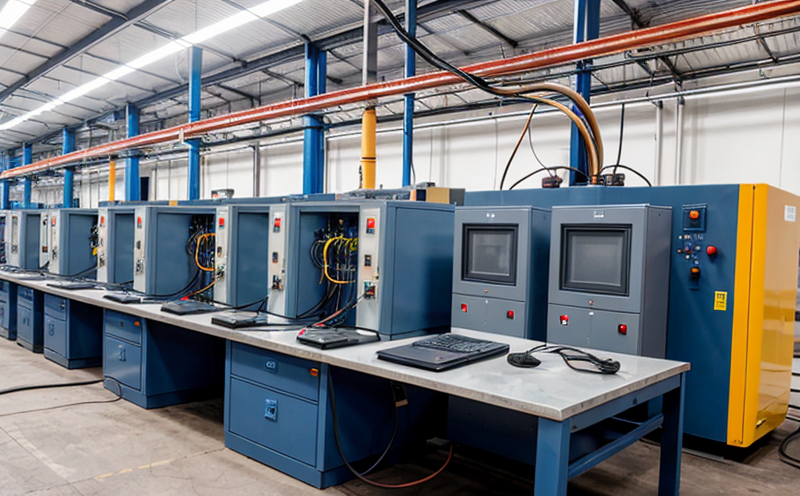Flame Retardant Efficacy Screening Test
The Flame Retardant Efficacy Screening Test is a critical step in ensuring that materials used within industrial electrical and control systems meet stringent safety standards. This test evaluates the ability of a material to resist ignition, burn, or produce heat under specific conditions. In industrial manufacturing and processing environments, where electrical and electronic components are integral to operations, flame retardant properties are essential for preventing fires and minimizing damage during accidental ignitions.
The Flame Retardant Efficacy Screening Test typically involves exposing a sample of the material to a source of ignition under controlled conditions. The test assesses how long it takes for the material to ignite, how rapidly it burns, and whether it continues to burn after removal from the heat source. This information is crucial for understanding not only the immediate fire risk but also the duration and extent of any potential damage.
The testing process adheres to international standards such as ASTM E640-18 and IEC 60332, which provide guidelines on flame retardant performance. The test is particularly relevant in sectors where electrical systems operate continuously or are exposed to high heat environments. Compliance with these standards ensures that the materials used are not only safe but also contribute to overall safety protocols within industrial facilities.
For quality managers and compliance officers, this test offers a robust method for ensuring that all components meet stringent fire safety regulations. In R&D environments, it provides valuable data on the effectiveness of different flame retardant additives or materials. For procurement departments, it helps in selecting suppliers who adhere to these critical standards.
- ASTM E640-18: This standard evaluates the ignition and propagation characteristics of materials under specified conditions.
- IEC 60332: Provides a series of tests for assessing the fire resistance of insulated conductors, cables, and other electrical components.
The test is performed using specialized equipment that can simulate real-world scenarios. Specimens are typically cut into standard dimensions to ensure consistency across testing batches. The process involves placing these specimens in a chamber where they are subjected to controlled heating or exposure to an open flame. The duration of the test, temperature settings, and other parameters are carefully documented to ensure accurate results.
Once the test is completed, detailed reports are generated that include data on ignition time, burn rate, and whether the specimen continues burning after removal from the heat source. These reports serve as a critical tool for decision-makers in selecting materials that not only meet regulatory requirements but also enhance safety within industrial environments.
For those considering this service, it's important to understand that the Flame Retardant Efficacy Screening Test is part of a broader suite of tests used in industrial electrical and control systems. It complements other tests such as dielectric strength testing, insulation resistance measurement, and short circuit protection assessment.
Why Choose This Test
Selecting the Flame Retardant Efficacy Screening Test is a strategic decision for any organization involved in industrial manufacturing or processing. The test offers several key advantages:
- Enhanced Safety: By ensuring that materials used in electrical and control systems are flame retardant, this test significantly reduces the risk of fires within industrial facilities.
- Compliance with Standards: Adherence to international standards such as ASTM E640-18 and IEC 60332 ensures that materials meet regulatory requirements, thereby reducing the likelihood of non-compliance penalties.
- Improved Reputation: Demonstrating a commitment to safety through rigorous testing can enhance an organization's reputation among clients and stakeholders.
- Cost-Effective Solutions: Early identification of materials with insufficient flame retardant properties allows for corrective actions, potentially saving on expensive recalls or repairs later.
The test is particularly valuable for organizations that need to ensure the safety of their products and processes. For quality managers, compliance officers, R&D engineers, and procurement teams, this service provides a reliable method for identifying materials with superior flame retardant properties.
International Acceptance and Recognition
The Flame Retardant Efficacy Screening Test is widely recognized across various countries due to its alignment with international standards. ASTM E640-18, for instance, is accepted in the United States and other English-speaking countries, while IEC 60332 enjoys global recognition.
- ASTM E640-18: This standard is widely used in the United States and Canada. It provides a comprehensive framework for evaluating materials based on ignition and propagation characteristics.
- IEC 60332: This series of standards is recognized globally, particularly in Europe and Asia. It offers specific tests for assessing fire resistance in insulated conductors and cables.
The acceptance of these standards ensures that the results from Flame Retardant Efficacy Screening Tests are widely understood and trusted across different regions. This global recognition is crucial for international trade, as it allows materials to be easily certified and accepted in various markets without requiring additional testing.
Use Cases and Application Examples
- Electrical Panels: Flame retardant properties are essential for electrical panels used in industrial settings, where they are exposed to high temperatures and potential ignition sources.
- Cable Assemblies: Insulated conductors and cables must be flame retardant to prevent the spread of fire within complex industrial systems.
- Transformers and Switchgear: These components require materials that can withstand high temperatures and provide a barrier against fires, making flame retardant testing critical.
- Control Panels: Flame retardant properties are vital for control panels used in environments where electrical systems operate continuously.
In addition to these examples, the test is also applicable to any industrial application where materials may come into contact with heat sources or be exposed to potential ignition. The results of this testing can significantly impact the design and development phases of new products, ensuring that they meet not only current standards but are also prepared for future regulatory changes.





